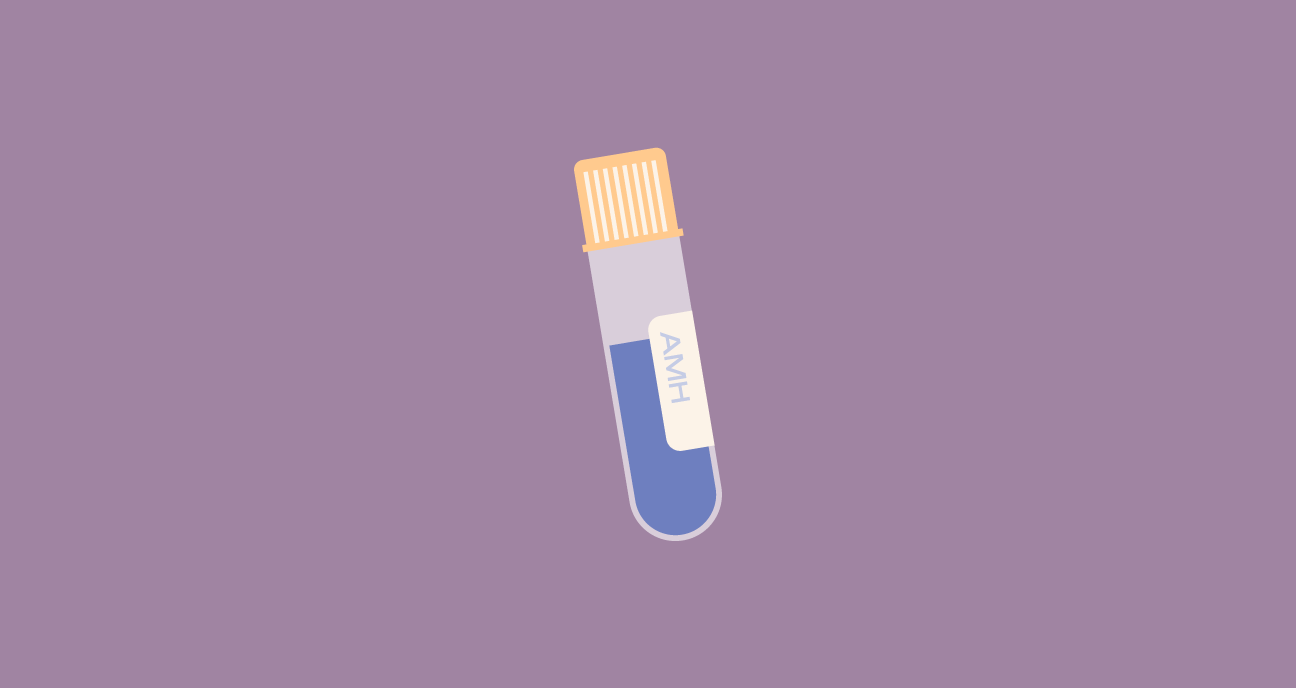Understanding AMH Levels by Age

Medically reviewed by Linda Streety, RN, BSN
Your clinician may order an AMH (anti-müllerian hormone) test to get a sense of how many eggs you produce each month and start to get a picture of your overall fertility potential. But what is AMH and what can it tell you about your fertility?
What is AMH and what can it tell you about your ovarian reserve?
Let’s start by talking about follicles – tiny, fluid-filled sacs in your ovaries, each containing an immature egg. It may surprise you to know that if you have ovaries, you are born with all the follicles you will ever have! These follicles stay dormant until they are recruited to grow by a carefully orchestrated series of hormones. Once recruited, the follicles grow and develop for about 300 days, during which they begin to secrete a protein called anti-müllerian hormone (AMH). Over time, most of these follicles die off in a process called apoptosis, so that only one egg on average reaches maturity and is ovulated.
Since the number of follicles growing in your ovaries corresponds to the amount of AMH in your blood, measuring your AMH can give your doctor a sense of how many follicles remain in your ovaries (1), also known as your ovarian reserve.
If you are planning to freeze your eggs or undergo in vitro fertilization (IVF), your AMH blood test will help your reproductive endocrinologist (RE) understand your potential for success with IVF and predict how many eggs you might retrieve in an IVF cycle. Your AMH level will also help determine your medication protocol for the ovarian stimulation part of egg freezing or IVF, during which your ovaries are stimulated with hormone medications to grow multiple eggs which can then be retrieved.
What DOESN’T an AMH test tell you?
While an AMH test can help your clinician understand the quantity of follicles you may develop each menstrual cycle, it doesn’t give them information about your egg quality. For example, ten eggs retrieved from a patient under 30 for IVF are more likely to be chromosomally normal than ten eggs retrieved from a patient over 40, even if their AMH levels are the same.
AMH is useful for predicting your chance of success with IVF, but it won’t tell you how successful you will be if you try to conceive naturally. In other words, a low AMH does not appear to correlate with lower fertility if you are trying to get pregnant without help (2).
AMH levels by age chart
A normal AMH level tends to fall between 1.2 - <5 ng/mL regardless of your age. If you have a normal AMH level, you likely have the expected number of eggs for your age! Below we show the ranges for low, slightly low, normal, slightly high, and high AMH levels by age group.

What does it mean if I have a high or low AMH?
Low or slightly low AMH level implications
This may indicate low ovarian reserve (also known as diminished ovarian reserve). It is an indicator that you have fewer follicles in your ovaries than most people your age, and predicts a lower than average result from IVF. While this is relevant for IVF, during which doctors will try to retrieve many eggs per cycle in order to give you the best chance of success, it does not correlate to your chance of success if you try to conceive naturally (3).
High or slightly high AMH implications
This may indicate polycystic ovary syndrome (PCOS), a hormone imbalance that may make it difficult to conceive. It may also indicate that you are at a higher risk of developing ovarian hyperstimulation syndrome (OHSS) from ovarian stimulation during IVF. OHSS is an uncomfortable and potentially dangerous condition that may occur if you developed a large number of follicles (more than 20) and/or had high estrogen levels before the egg retrieval procedure.
How do you get an AMH test, and does it matter when?
While some baseline fertility tests need to be performed on a certain day of your menstrual cycle, AMH doesn’t fluctuate much since it’s largely produced by immature follicles. As a result, you can have your AMH tested on any day of your menstrual cycle. Also, though your AMH may fluctuate slightly from test to test, your ovarian reserve does not (waiting for a better AMH result will not improve your outcome from IVF.)
For an AMH test, a phlebotomist will conduct a simple blood test: they will draw some blood from your arm and send it to the lab. You will typically get your results from the test within the week.
There are several ways to get your AMH tested:
Ask your doctor
Your doctor does not need to be a fertility specialist; a primary care doctor can also help you order the test. However, for a complete picture of your fertility, it is best to see a fertility specialist who can help you interpret the test results and order additional tests to get a more holistic picture of your ovarian reserve and fertility potential. A fertility specialist can also identify specific reasons why you may be experiencing infertility, such as endometriosis or tubal factor infertility.
Schedule your own appointment at a walk-in lab
If you prefer to skip a visit to your doctor, you can schedule your own blood test through Labcorp. They offer a fertility testing package and you will receive your results through them.
Test at home
If you prefer not going to a doctor’s office, you can do an at-home fertility test to get your AMH results. These use a finger prick blood sample to conduct the test.
How does AMH relate to other fertility tests, such as FSH and AFC?
Follicle stimulating hormone (FSH) is secreted by the pituitary gland to stimulate follicle development and control the menstrual cycle. As a result, FSH is another valuable window your fertility specialist may use to understand your fertility potential.
Since FSH helps to regulate the menstrual cycle, the FSH test needs to be conducted on a specific day, typically 2-4 days after your menstrual cycle begins. High FSH levels and low AMH at this point of the cycle may indicate poor ovarian function, menopause, or perimenopause. Conversely, low FSH levels may indicate pituitary gland dysfunction or PCOS.
If you are getting baseline fertility tests conducted, your fertility specialist will likely also order a baseline ultrasound about 2-5 days after your menstrual cycle begins to check on your antral follicle count (AFC). Your AFC will be the number of follicles above 8 mm that you have that month. Together with your FSH and AMH, your AFC will contribute to your fertility specialist’s picture of your potential success with infertility treatment.
How much does AMH matter for IVF success?
AMH is helpful for predicting your chance of success with IVF, but it’s only one aspect of many to consider in assessing your fertility and chance of IVF success. Your FSH and AFC also matter, as well as your age, BMI, prior birth history, and fertility diagnoses. Together, these give your reproductive endocrinologist (RE) a more holistic picture of your fertility and can help predict your chance of a live birth with IVF.
How did Alife define its AMH reference range?
Reference ranges help you compare your test results to a “normal,” or healthy, population. Reference ranges use the test results from the middle 95% of that healthy population since outliers may have a diagnosis or health issue that can skew the results. For AMH levels, Alife provides low, slightly low, normal, slightly high, and high values for different age groups so you can see where your AMH falls.
Low
- Alife defines “Low” as an AMH that is below the 95% reference range defined by the Beckman Coulter Access AMH assay.
Slightly Low
- Alife defines values below 1.2 ng/mL as “Slightly Low”. These “Slightly Low” ranges are within the 95% reference range defined by the Beckman Coulter assay, but are low enough that they may have implications for fertility.
- The cut-off of 1.2 ng/mL of AMH is from the POSEIDON criteria, which was developed to identify and classify low-prognosis patients undergoing ART treatment. This criteria established 1.2 ng/mL as a threshold for poor ovarian response (4).
Slightly High
- 18-35 years old: Alife defines values between 5.0 ng/mL and 10.0 ng/mL as “Slightly High.” We use this clinical decision limit because patients with AMH levels between 5 - 10 ng/mL have a higher rate of PCOS and risk of OHSS compared to patients with AMH levels that are less than 5.0 ng/mL (5).
- Over 35 years old: Alife does not establish a “slightly high” range since AMH levels decline with age, and the upper limit of the 95% reference range for this age group is less than 5 ng/mL.
High
- 18-35 years old: Alife defines a “High” AMH as any AMH level greater than 10 ng/mL. This is because patients with an AMH greater than 10 ng/mL have a greater prevalence of PCOS and are associated with greater OHSS risk (6).
- Over 35 years old: Since AMH levels decline with age, Alife defines “High” AMH as any AMH level that is above the 95% reference range for that age group as defined by the Beckman Coulter Access AMH assay.
Recent Articles
References
-
Aslan, Kiper, et al. “WHICH IS MORE PREDICTIVE OVARIAN RESERVE MARKER WHEN THERE IS DISCORDANCE between ANTI - MULLERIAN HORMONE and ANTRAL FOLLICLE COUNT in PATIENTS with DIMINISHED OVARIAN RESERVE, AMH or AFC?” Fertility and Sterility, vol. 114, no. 3, Sept. 2020, pp. e463–e464, https://doi.org/10.1016/j.fertnstert.2020.08.1333. Accessed 3 July 2021.
-
Lin, C., Jing, M., Zhu, W., Tu, X., Chen, Q., Wang, X., Zheng, Y., & Zhang, R. (2021). The Value of Anti-Müllerian Hormone in the Prediction of Spontaneous Pregnancy: A Systematic Review and Meta-Analysis. Frontiers in Endocrinology, 12. https://doi.org/10.3389/fendo.2021.695157
-
Streuli, I., de Mouzon, J., Paccolat, C., Chapron, C., Petignat, P., Irion, O. P., & de Ziegler, D. (2014). AMH concentration is not related to effective time to pregnancy in women who conceive naturally. Reproductive BioMedicine Online, 28(2), 216–224. https://doi.org/10.1016/j.rbmo.2013.10.007
-
Esteves, S. C., Alviggi, C., Humaidan, P., Fischer, R., Andersen, C. Y., Conforti, A., Bühler, K., Sunkara, S. K., Polyzos, N. P., Galliano, D., Grynberg, M., Yarali, H., Özbek, I. Y., Roque, M., Vuong, L. N., Banker, M., Rienzi, L., Vaiarelli, A., Cimadomo, D., & Ubaldi, F. M. (2019). The POSEIDON Criteria and Its Measure of Success Through the Eyes of Clinicians and Embryologists. Frontiers in Endocrinology, 10, 814. https://doi.org/10.3389/fendo.2019.00814
-
Tal, R., Seifer, D. B., Khanimov, M., Malter, H. E., Grazi, R. V., & Leader, B. (2014). Characterization of women with elevated antimüllerian hormone levels (AMH): correlation of AMH with polycystic ovarian syndrome phenotypes and assisted reproductive technology outcomes. American Journal of Obstetrics and Gynecology, 211(1), 59.e1–59.e8. https://doi.org/10.1016/j.ajog.2014.02.026
-
Tal, R., Seifer, D. B., Khanimov, M., Malter, H. E., Grazi, R. V., & Leader, B. (2014b). Characterization of women with elevated antimüllerian hormone levels (AMH): correlation of AMH with polycystic ovarian syndrome phenotypes and assisted reproductive technology outcomes. American Journal of Obstetrics and Gynecology, 211(1), 59.e1–59.e8. https://doi.org/10.1016/j.ajog.2014.02.026
Share this
Recent Articles

Learn everything you need to know about IVF
Join the newsletter for IVF education, updates on new research, and early access to Alife products.



